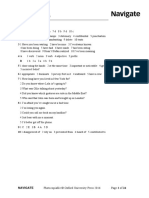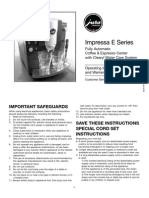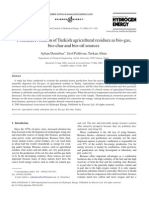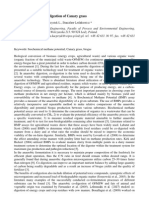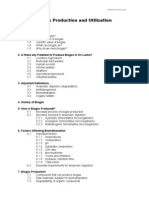Extraction of Methane From Natural Product and Natural Wastes: A Review
Extraction of Methane From Natural Product and Natural Wastes: A Review
Uploaded by
Biswa Jyoti GuptaCopyright:
Available Formats
Extraction of Methane From Natural Product and Natural Wastes: A Review
Extraction of Methane From Natural Product and Natural Wastes: A Review
Uploaded by
Biswa Jyoti GuptaOriginal Description:
Original Title
Copyright
Available Formats
Share this document
Did you find this document useful?
Is this content inappropriate?
Copyright:
Available Formats
Extraction of Methane From Natural Product and Natural Wastes: A Review
Extraction of Methane From Natural Product and Natural Wastes: A Review
Uploaded by
Biswa Jyoti GuptaCopyright:
Available Formats
International Journal of Engineering Trends and Technology (IJETT) – Volume 17 Number 4 – Nov 2014
Extraction of Methane from Natural Product
and Natural Wastes: A Review
T. Manoj #1, D. Ravichandran *2
#1
PG Student, Department Of Mechanical Engineering, Nandha Engineering College,Erode-638052,India.
*2
Assistant Professor, Department Of Mechanical Engineering, Nandha Engineering College, Erode 638052,India.
Abstract -The present day energy crisis brings the alternate Methane on combustion produce a heat of
way of energy production by bio gas. Bio gas is the 55.5MJ/KG. Natural methane is produced by
alternative energy source and it is the one, which is
methanogenesis process.
economically compact and has high potential. The
production of methane gas from biomass has been CO2 + 8 H+ + 8 e− → CH4 + 2 H2O
suggested as a lesson that tells the demand for natural gas
and utilizing the reservoirs of methane on the environment. In this paper a literature survey is taken
The bio gas is extracted by Anaerobic digestion of wastes, about the methane production from various natural
which was carried out in the batch scale under ambient matters. The various production techniques and their
temperature. The bio gas production was measured in daily results were summarized below.
basis by the liquid displacement method. The digested
slurry can be used in agricultural field as a fertilizer. II. LITERATURE SURVEY
Keywords- alternate energy, anaerobic process, fossil fuels, The author describes the production of
wastes. methane from the municipal and industrial waste.
These wastes are collected in the anaerobic digester
I. INTRODUCTION
which produce methane gas. These wastes emit 6-
Biogas is the mixture of gas produced by the 18% of methane to the atmosphere. Here the methane
breakdown of organic matter in the absence of is properly utilized from the solid waste and
oxygen. It can be produced from available raw minimize the atmospheric pollution [1]. The
materials such as recycled waste. It is renewable methane emission from cattle, ruminant livestock
energy with less carbon footprint. Biogas mainly produce 250-500L of methane per day. Methane
contains methane (CH4), carbon dioxide (CO2), and emission is measured by mass balance and other
rarely a small amount of hydrogen sulfide (H2S). techniques. The idea here is to reduce methane in the
atmosphere to avoid global warming [2]. The author
Methane is the simplest alkane and its
investigates the rate of conversion to methane of
relative abundance makes it as an attractive fuel.
different fruits and their parts. Here 54 varieties of
Methane is present in the nature like fruits,
fruits and vegetables were compared with the
vegetables, seeds, etc. The methane is extracted from
standard biomass. The methane yield and kinetics
these sources and they can be used as a alternate
were differing for different parts of the same variable.
source of fuel.
From this they said mango peels, citrus waste yield
methane of P<0.05, that produces 90% of methane
ISSN: 2231-5381 http://www.ijettjournal.org Page 159
International Journal of Engineering Trends and Technology (IJETT) – Volume 17 Number 4 – Nov 2014
in40-50 days [3]. They describe the extraction of developed to separate the organic and inorganic
methane from methane hydrate by using the laser as a material from solid waste. The organic matter is then
tool. It is the superior then other methods of used in bio reactor, it contains 5o% of solid waste ,
extraction of methane. The types of lasers suit for volatile solid of 36%. After the methane yield 38% of
methane production is discussed. The most effective total solid and 53% of volatile solid was reduced.
one is chemically pumped oxygen-iodine energy From this APS digester is effective for digestion of
transfer, laser (COIL) [4]. The author proposed the organic waste. Future scope is to increase the
idea of the reduction of methane and nitrous oxide in performance of APS digester by increase the rate of
order to prevent the green house emission and also a liquid circulation [9].
economic analysis. The various techniques which are
economically less are described properly using the The extraction of methane from the jatropha
methane and nitrous oxide as an alternate source [5]. de-oiled cake and orange peel in an anaerobic
digester. The maximum gas production is obtained
The author describes the potential of bio gas for the ratio 1:2 0f jatropha de oiled cake and orange
production of cotton wastes like cotton oil cake, peel. The gas contains 75% of methane, 16% of
cotton seed hull and cotton stalks. The experiment carbon dioxide and 9% of CO [10]. The author
was carried out under two different concentrations describes the anaerobic digestion of cow dung in the
like 30 and 60 g/l. After the anaerobic digestion of digester produce methane. The cow dung has 40-60%
these wastes produce 65, 86 and 78 ml of methane in of methane. The mesopholic anaerobic digestion of
23 days for 1g of stalks, seed hull and oil cake 440kg cow dung in the 800 liter capacity digester
respectively. The basal medium increases the bio gas produces 26.478m3 of bags for 77 days with an
production [6]. The prediction of methane generation average of 61% of methane [11]. The methane
using simple methods in tropical landfills. Simple production rate in first stage and second stage
procedure to estimate methane production potential digester. Fruits and vegetable waste are added to both
and biodegradation rate are discussed. The first order the digester after 10 days the methane in the first
decay method is used here. This paper compares both stage reactor was 514 ± 57 L and in second stage 392
the field result and the laboratory result. The ± 16 L. From this first stage reactor is suitable for
laboratory result is smaller than field due to the high methane generation [12]. The investigation is
moisture content which affect the degradation rate done by the author for the effective treatment of
[7]. The methane gas is produced during the municipal bio waste by pilot scale anaerobic
formation of coal under high temperature and digestion and it reduces the emission of greenhouse
pressure. This is also called coal mine methane gas. Municipal waste includes fruits, sewage and
(CMM) which is extracted from the mine by drilling, food waste. The 16.5% of lipid content was useful for
long drill.. Etc, The best optimized design is required bio gas production before the anaerobic process
for that full parameters and data has to know [8]. starts. Thus the anaerobic co-digestion is good
The integrated rotary drum reactor was assisted with solution to treat municipal waste and control green
the anaerobic phase solid digester to convert house gas. CHG was reduced to 114 and 523 kg co2
-1
municipal waste into the bio gas. RDR was et . [13] .The author examines the ratio of feedstock
ISSN: 2231-5381 http://www.ijettjournal.org Page 160
International Journal of Engineering Trends and Technology (IJETT) – Volume 17 Number 4 – Nov 2014
and its effect in the bio gas production. Rice husk combustible gas. By heating the waste the efficiency
along with the kitchen waste and pig manure was is increased. Implementing this technology with
digested by anaerobic process in the single stage anaerobic digester the pollution can be avoided and
reactor. The effective result shows 45.9-70% of bio gas, and fertilizers are obtained [17].
methane in the ratio 0.4: 1.6: 1 of kitchen waste, pig
The author reviews the environmental
manure and rice stack. The total bio gas yield for
pollution due to discharge of large amounts of food
67.44 L/KG VS is higher than pig manure and rice
waste. The food waste was converted into bio gas by
stack alone by 71.6% and 10.41% kitchen waste
anaerobic process. The food waste characteristics,
produces more than 26%. The bio gas production was
anaerobic digestion principle and parameters are
inhibited by lactic acid and acetate. The reduction
studied. The volatile fatty acid was added for high
rate of volatile solid was 55.8%. By adding kitchen
methane yield and stability. The other way to
waste and pig manure along with rice stack the bio
improve the methane yield is by adding cattle manure
gas production gets higher [14].
along the food waste . [18].
The author examines the Phyllanthus
The author here investigates the anaerobic
emblica residues and food waste for the methane
digestion of various forestry wastes. The tropical bio
production. Phyllanthus emblica residues singly, not
waste was investigated for bio gas production by
suitable for bio gas production because it contains
solid state and liquid state anaerobic digestion. The
methanogenic inhibitor. Three bio reactors were
L-AD produce 161 and 113 LKg-1VS of methane and
examined one for food digestion, second for PER
solid state AD produce 156.8 and 59.6 LKg-1VS of
digestion and third for co-digestion of PER and food
methane. SS-AD achieve higher volumetric methane
waste. Bio-gas production from co-digestion was
production than L-AD. Compare to all the leaves and
greater than that of other two digestion reactor. The
woods obese have a higher methane yield. Anaerobic
experiment was conducted both in pilot scale and lab
digester is good for treat food wastes [19]. The author
scale reactor. Pilot scale reactor results, 34% increase
studies the production of bio gas from various
in methane production from PER and food waste co-
biomasses like lemon grass, poultry waste and cow
digestion [15]. The biogas production from the
dung. The feed is mixed with water in the ratio of 1:1
various waste materials such as human waste,
and left for 30 days for digestion, which produce
vegetables, municipal waste etc.…. The biogas
0.125m3, 0.211m3 and 0.191m3 of bio gas. Lemon
contain 50-60% of methane and 25-45% of carbon
grass produces lower bio gas than other two. But the
dioxide. Bio gas is formed by the digestion of waste
quality of bio gas from lemon grass was good [20].
by anaerobic process [16]. The author introduces the
new constructive technology to the anaerobic digester III. CONCLUSION
that does not need external energy , which is to clean The various papers that described the
the birds and animal waste and convert it into two methane production which is the alternate source of
useful products. The products are combustible gas fuel in the future and its various sources and
and fertilizers. The advantages of this technology are production techniques are reviewed. This survey
small, self-regulated and produce 15-20% of reveals that almost the nature’s entire product like
ISSN: 2231-5381 http://www.ijettjournal.org Page 161
International Journal of Engineering Trends and Technology (IJETT) – Volume 17 Number 4 – Nov 2014
fruits, vegetables and other natural waste has the and anaerobic-phased solids digester system, Bioresource
Technology 101 (2010) 6374–6380
potential to produce methane. Conversion rate of bio
[10] Periyasamy Elaiyaraju and Nagarajan Partha..,
mass to methane was different for each bio mass
Biogas production from co-digestion of orange peel waste and
type. Catalysts can add to increase the speed of the jatropha de-oiled cake in an anaerobic batch reactor, African
reaction. After extraction of methane large amount journal of biotechnology, Vol. 11(14), pp. 3339-3345.
[11] Amel Ounnar.., Lamia Benhabyles.., Sadek
of de-oiled waste is produced and left unused.The
Igoud.., Energitic valorization of biomethane produced from cow
wastes are recycled and converted into use full bio
dung, procedia engineering 33 (2012) 330 – 334.
gas. Methane extraction from de-oiled wastes are not [12] Nathan D. Park, Ronald W. Thring and Steve S.
adequately addressed and tried. Helle..,Comparison of methane production by co-digesting fruit
and vegetable waste with first stage and second stage anaerobic
Future scope in this area is to extract
digester sludge from a two stage digester,water science and
methane from the various de-oiled wastes and
technology 65.7, 2012.
techniques to improve the performance of an [13] Xiao Liu.., Xingbao Gao .., Wei Wang..,Pilot-scale
anaerobic digester. anaerobic co-digestion of municipal biomass waste: Focusing on
biogas
REFERENCES
production and GHG reduction, Renewable Energy 44 (2012)
[1] H. G. BINGEMER.., The production of methane
463e468.
from solid waste, journal of geophysical research, vol. 92, no. d2,
[14] Jingqing Ye.., Dong Li.., Yongming
pages 2181-218, February 20,1987.
Sun..,Improved biogas production from rice straw by co-digestion
[2] K A Johnson.., D E Johnson.., Methane emission
with
from cattle, the journal of animal science 73:2483-2492 1995.
kitchen waste and pig manure, Waste Management 33 (2013)
[3] V. Nallathambi Gunaseelan.., Biochemical methane
2653–2658.
potential of fruits and vegetable solid waste feedstocks, biomass
[15] Siriwan Panyadee.., Anurak Petiraksakul ..,
and bio energy 26 (2004) 389 – 399.
Chantaraporn Phalakornkule..,Biogas production from co-digestion
[4] Tomoo FUJIOKA..,Kazuya JYOSUI..,,Hiroyuki
of Phyllanthus emblica residues and food waste, Energy for
NISHIMURA.., Kazuyoku TEI..,Extraction of methane from
Sustainable Development 17 (2013) 515–520.
methane hydrate using lasers, the japan society of applied physics,
[16] Emil Nutiu..,Anaerobic purification installation
Vol. 42 (2003) pp. 5648–5651.
with production of biogas and
[5] Mitigation of Methane and Nitrous Oxide Emissions
liquid fertilizers, Procedia Technology 12 ( 2014 ) 632 – 636.
from Waste, Energy and Industry, the energy journal, 2006.
[17] Cunsheng Zhang.., HaijiaSu.., JanBaeyens..,
[6] A. Iscia.., G.N. Demirer.., Biogas production
TianweiTan.a ,Reviewing the anaerobic digestion of food waste for
potential from cotton wastes, Renewable Energy 32 (2007) 750–
biogas production,
757.
renewableandSustainableEnergyReviews38(2014)383–392.
[7] Sandro L. Machado.., Miriam F. Carvalho ..,Jean-
[18] Xumeng Ge.., Tracie Matsumoto.., Lisa Keith..,
Pierre Gourc.., Orencio M. Vilar.., Methane generation in tropical
Yebo Li..,Biogas energy production from tropical biomass wastes
landfills : simplified methods and field results, waste management
by anaerobic digestion, bioresource Technology 169 (2014) 38–44.
29 (2009) 153–161.
[19] Dhameliya Prathmika.., Biogas Production from
[8] LI Guo-jun.., Theoretical research and practice on
Different Waste Matireals in India , the international journal of
coal mine methane extraction and ground development design,
science and technology, vol 2 issue 6, 2014.
procedia earth and planetary science 1 (2009) 94–99.
[20] I.M. Alfa ..,S.O. Dahunsi ..,O.T. Iorhemen
[9] Baoning Zhu..,Ruihong Zhang.., Petros Gikas..,
..,C.C.Okafor .., S.A. Ajayi..Comparative evaluation of biogas
Joshua Rapport.., Bryan Jenkins..,Biogas production from
production from Poultry droppings ,Cow dung and Lemon grass,
municipal solid wastes using an integrated rotary drum
Bio resource Technology 157 (2014) 270–277.
ISSN: 2231-5381 http://www.ijettjournal.org Page 162
You might also like
- Unit Tests AnswersDocument24 pagesUnit Tests AnswersNanman Thaiman80% (10)
- Farmer's Dreams (This Is My Walkthough) : Made by Masa0000Document27 pagesFarmer's Dreams (This Is My Walkthough) : Made by Masa0000Yoan Gonzalez ZayasNo ratings yet
- Influences of Foreign Culture in The PhilippinesDocument2 pagesInfluences of Foreign Culture in The PhilippinesKalachuchiNo ratings yet
- Press MUd To Bio GasDocument5 pagesPress MUd To Bio GasAyush Agrawal100% (1)
- Biogas Plant: Biogas Digester Design, Gas Production and PurificationFrom EverandBiogas Plant: Biogas Digester Design, Gas Production and PurificationRating: 3 out of 5 stars3/5 (1)
- Vaidyas of Bengal ModifiedDocument27 pagesVaidyas of Bengal ModifiedBiswa Jyoti Gupta100% (4)
- Vaidyas of Bengal ModifiedDocument27 pagesVaidyas of Bengal ModifiedBiswa Jyoti Gupta100% (4)
- Methodology CO2-Tool Electricity Gas and Heat From Biomass - Version 1Document47 pagesMethodology CO2-Tool Electricity Gas and Heat From Biomass - Version 1Biswa Jyoti GuptaNo ratings yet
- Cake Making: by Mrs. M. PittDocument31 pagesCake Making: by Mrs. M. PittErich Viray100% (1)
- E8 Jura Capresso ManualDocument24 pagesE8 Jura Capresso ManualBruce DuttenhoferNo ratings yet
- Take The Ice by Bell A Marie 117 CompleteDocument644 pagesTake The Ice by Bell A Marie 117 CompleteDyan Angelica67% (3)
- 1 s2.0 S2667010021002419 MainDocument8 pages1 s2.0 S2667010021002419 MainUlrich DJIKPENo ratings yet
- A Review On Production of Biogas From SL PDFDocument5 pagesA Review On Production of Biogas From SL PDFJosephine ChirwaNo ratings yet
- Effect of Adding Palm Oil Mill Effluent (POME) and Slurry On Biogas From Cow Manure To Produced Methane GasDocument6 pagesEffect of Adding Palm Oil Mill Effluent (POME) and Slurry On Biogas From Cow Manure To Produced Methane GasDurrah QusyairiNo ratings yet
- ANTONOPOULOU - 2015 - Modeling of Anaerobic Digestion of Food Industry WastesDocument7 pagesANTONOPOULOU - 2015 - Modeling of Anaerobic Digestion of Food Industry WastesThobiasNo ratings yet
- 2017-Fixed Bed Pyrolysis of Lemongrass (CymbopogonDocument11 pages2017-Fixed Bed Pyrolysis of Lemongrass (Cymbopogonmatheshwaran.mNo ratings yet
- Extraction of Methane From Biogas - FinalDocument23 pagesExtraction of Methane From Biogas - FinaldhanushNo ratings yet
- Sustainable Energy Expansion Tactics in The Sub Sahara Botswana Design and Development of An Advanced Biogas DigesterDocument7 pagesSustainable Energy Expansion Tactics in The Sub Sahara Botswana Design and Development of An Advanced Biogas DigesterIJMTERNo ratings yet
- Methanol Synthesis From Biogas A Thermodynamic AnalysisDocument12 pagesMethanol Synthesis From Biogas A Thermodynamic AnalysisOmar Duvan RodriguezNo ratings yet
- Research ArticleDocument12 pagesResearch ArticlePranavNo ratings yet
- 6.analysis and Managementof Methane Emissions From Dumping Pond A Cases Study at FeldaJengka 8 Palm Oil Mill (Khairuddin MN) PP 35-41Document7 pages6.analysis and Managementof Methane Emissions From Dumping Pond A Cases Study at FeldaJengka 8 Palm Oil Mill (Khairuddin MN) PP 35-41upenapahangNo ratings yet
- Ayhan DemirbasDocument8 pagesAyhan DemirbasLalta PrasadNo ratings yet
- 5959 Ijmme Ijens PDFDocument5 pages5959 Ijmme Ijens PDFGarudaOzoNo ratings yet
- Production of Biogas From BiomassDocument11 pagesProduction of Biogas From BiomassEphrem GizachewNo ratings yet
- Biogas Production From SludgeDocument4 pagesBiogas Production From Sludgeravi1214No ratings yet
- Use of Biogas As Alternative Fuel For Tobacco Curing: Case For ZimbabweDocument11 pagesUse of Biogas As Alternative Fuel For Tobacco Curing: Case For ZimbabweLawrence ChibvuriNo ratings yet
- 405 408Document5 pages405 408SURESHNo ratings yet
- Modeling of Anaerobic Digestion of Canary GrassDocument8 pagesModeling of Anaerobic Digestion of Canary GrassProAkademiaNo ratings yet
- Biogas Project ReportDocument69 pagesBiogas Project ReportKetan V. JoshiNo ratings yet
- 1 s2.0 S2772427122000122 MainDocument13 pages1 s2.0 S2772427122000122 MainshadabNo ratings yet
- Projeto Experimental Fatorial para Aumentar A Produção de Metano Na Digestão de Resíduos LácteosDocument7 pagesProjeto Experimental Fatorial para Aumentar A Produção de Metano Na Digestão de Resíduos LácteosLuís Paulo CardosoNo ratings yet
- Baseline Study of Methane Emission From Anaerobic Ponds PDFDocument10 pagesBaseline Study of Methane Emission From Anaerobic Ponds PDFLaura GarciaNo ratings yet
- Biogas Recovery From Anaerobic Digestion Process of MixedDocument7 pagesBiogas Recovery From Anaerobic Digestion Process of MixedSushil MeshramNo ratings yet
- Mesophilic Biodigestion of Cowdung and Mango Peel in Relation to Bioenergy-batch StudyDocument5 pagesMesophilic Biodigestion of Cowdung and Mango Peel in Relation to Bioenergy-batch StudyJuan Pablo dos Santos MirandaNo ratings yet
- Biochemical Engineering Journal: Regular ArticleDocument9 pagesBiochemical Engineering Journal: Regular Articlehenry martinez quiñonezNo ratings yet
- 2018-Flash Pyrolysis of Lemon Grass (Cymbopogon Flexuosus) For Biooil Production in An Electrically Heated Fluidized Bed ReactorDocument10 pages2018-Flash Pyrolysis of Lemon Grass (Cymbopogon Flexuosus) For Biooil Production in An Electrically Heated Fluidized Bed Reactormatheshwaran.mNo ratings yet
- Corredor (2019) Techno-Economic Evaluation of A Process For Direct Conversion of MethaneDocument7 pagesCorredor (2019) Techno-Economic Evaluation of A Process For Direct Conversion of MethaneANGIE NATALYA MORALES DUCUARANo ratings yet
- Ijert PaperDocument5 pagesIjert PaperSri I.Balakrishna Assistant Professor (Sr.)No ratings yet
- 1 s2.0 S0959652619301908 MainDocument12 pages1 s2.0 S0959652619301908 MainLking LokeshNo ratings yet
- BIOGAS-Technology For IndiaDocument43 pagesBIOGAS-Technology For IndiaH.J.Prabhu100% (3)
- Wepik Unlocking The Potential Exploring The Biomethanation Process 20231204052903VtMFDocument12 pagesWepik Unlocking The Potential Exploring The Biomethanation Process 20231204052903VtMFM Rana DeepakNo ratings yet
- Methanol Synthesis From SyngasDocument38 pagesMethanol Synthesis From SyngasShahabuddin Khan NiaziNo ratings yet
- 1 s2.0 S0306261919313662 MainDocument16 pages1 s2.0 S0306261919313662 MainPravaNo ratings yet
- Ijet V3i6p18Document9 pagesIjet V3i6p18International Journal of Engineering and TechniquesNo ratings yet
- Anaerobic Treatment of Cattle Manure For Biogas ProductionDocument10 pagesAnaerobic Treatment of Cattle Manure For Biogas ProductionMohamed MahmoudNo ratings yet
- A Theoretical Study On Kinetic Model For Mesophilic and Thermophilic Temperature Regimes To Calculate Biogas Production: A Waste To Energy ThemeDocument13 pagesA Theoretical Study On Kinetic Model For Mesophilic and Thermophilic Temperature Regimes To Calculate Biogas Production: A Waste To Energy ThemeSaliha SattiNo ratings yet
- Ajol File Journals - 9 - Articles - 221710 - Submission - Proof - 221710 97 542917 2 10 20220224Document13 pagesAjol File Journals - 9 - Articles - 221710 - Submission - Proof - 221710 97 542917 2 10 20220224Abdullahi Tahiru SarajoNo ratings yet
- Biogas Production and UtilizationDocument28 pagesBiogas Production and UtilizationWijetunga Somasiri100% (2)
- Departemen Pertanian, 2006Document9 pagesDepartemen Pertanian, 2006Zainul Fikri TampengNo ratings yet
- A Novel of Biohythane Gaseous Fuel Production From Pineapple Peel WasteDocument9 pagesA Novel of Biohythane Gaseous Fuel Production From Pineapple Peel WasteHeber MarinNo ratings yet
- Biogas Production From Anaerobic Digestion of Different Biodegradable MaterialsDocument6 pagesBiogas Production From Anaerobic Digestion of Different Biodegradable MaterialsTeka TesfayeNo ratings yet
- Effect of Heating, Mixing and Digester Type On Biogas Production From Buffalo DungDocument25 pagesEffect of Heating, Mixing and Digester Type On Biogas Production From Buffalo DungAllein Loisse EspinozaNo ratings yet
- International Journal of Engineering and Science Invention (IJESI)Document5 pagesInternational Journal of Engineering and Science Invention (IJESI)inventionjournalsNo ratings yet
- Basics of Methanogenesis in Anaerobic DigesterDocument25 pagesBasics of Methanogenesis in Anaerobic DigesterErnesto AcevedoNo ratings yet
- Biomethanation of Banana Peel and Pineapple WasteDocument4 pagesBiomethanation of Banana Peel and Pineapple WasteolieNo ratings yet
- Biogas Production From Municipal Waste: Prospect in BangladeshDocument5 pagesBiogas Production From Municipal Waste: Prospect in BangladeshShaheen AlamNo ratings yet
- Lohrasbi Et Al - 2010 - Process Design and Economic Analysis of A Citrus Waste Biorefinery WithDocument7 pagesLohrasbi Et Al - 2010 - Process Design and Economic Analysis of A Citrus Waste Biorefinery WithJalcamNo ratings yet
- Research Article: Biogas Production From Food Waste Using NanocatalystDocument10 pagesResearch Article: Biogas Production From Food Waste Using NanocatalystBudi PriswantoNo ratings yet
- 1 s2.0 S2589014X23001470 MainDocument11 pages1 s2.0 S2589014X23001470 MainLuís Filipe De Almeida RoqueNo ratings yet
- Biogas Production From Co-Digestion of Selected Agricultural Wastes in NigeriaDocument10 pagesBiogas Production From Co-Digestion of Selected Agricultural Wastes in NigeriaAbdullahi Tahiru SarajoNo ratings yet
- BiomassDocument7 pagesBiomassJhonatan Romero HuarcayaNo ratings yet
- Anaerobic Digestion: Biology and BenefitsDocument10 pagesAnaerobic Digestion: Biology and Benefitswalidghoneim1970No ratings yet
- Optimization of Anaerobic Mechanism Using Response Surface Methodology (RSM) To Treat Pulp and Paper Industry Wastewater: A ReviewDocument9 pagesOptimization of Anaerobic Mechanism Using Response Surface Methodology (RSM) To Treat Pulp and Paper Industry Wastewater: A ReviewEditor IJTSRDNo ratings yet
- Biogas Production in The Anaerobic Treatment of Cattle ManureDocument8 pagesBiogas Production in The Anaerobic Treatment of Cattle Manuretera novaNo ratings yet
- Physio-Chemical Properties of Fruit and VegetablesDocument12 pagesPhysio-Chemical Properties of Fruit and VegetablesAgbalekpor IshmaelNo ratings yet
- Biogas Production From Anaerobic Digestion of Biodegradable Household WastesDocument6 pagesBiogas Production From Anaerobic Digestion of Biodegradable Household WastesTeka TesfayeNo ratings yet
- Chapter OneDocument46 pagesChapter OneibukunadedayoNo ratings yet
- Thermochemical Processing of Biomass: Conversion into Fuels, Chemicals and PowerFrom EverandThermochemical Processing of Biomass: Conversion into Fuels, Chemicals and PowerNo ratings yet
- The Total Synthesis of Natural ProductsFrom EverandThe Total Synthesis of Natural ProductsJohn ApSimonNo ratings yet
- Experiment 2 3 4 Total Solid Ts Total SuDocument9 pagesExperiment 2 3 4 Total Solid Ts Total SuBiswa Jyoti GuptaNo ratings yet
- Design Construction and Maintenance of A Biogas Generator PDFDocument23 pagesDesign Construction and Maintenance of A Biogas Generator PDFBiswa Jyoti GuptaNo ratings yet
- Subscription Scheme Smart Value For SbiDocument3 pagesSubscription Scheme Smart Value For SbiBiswa Jyoti GuptaNo ratings yet
- AFPRO 2005 Deenbandhu Model 2000 Biogas PlantDocument7 pagesAFPRO 2005 Deenbandhu Model 2000 Biogas PlantBiswa Jyoti GuptaNo ratings yet
- Monte Carlo Fashions Limited - RHP - 21 November 2014Document336 pagesMonte Carlo Fashions Limited - RHP - 21 November 2014Biswa Jyoti GuptaNo ratings yet
- LIC Housing Finance LTD FDDocument6 pagesLIC Housing Finance LTD FDBiswa Jyoti GuptaNo ratings yet
- Chapter 1-1-100pDocument100 pagesChapter 1-1-100pBiswa Jyoti GuptaNo ratings yet
- (Download) RBI Mains 2014 Paper 3: Finance and Management: InstructionsDocument2 pages(Download) RBI Mains 2014 Paper 3: Finance and Management: InstructionsBiswa Jyoti GuptaNo ratings yet
- 5th Eight Legged Creatures PDFDocument7 pages5th Eight Legged Creatures PDFNutmeg0% (1)
- Choose The Correct Answer by Crossing (X) On A, B, C, or D !Document6 pagesChoose The Correct Answer by Crossing (X) On A, B, C, or D !Dian KusumaNo ratings yet
- st6 Gram U10Document3 pagesst6 Gram U10mitziNo ratings yet
- to-be-verb-exercises-PDF-worksheet-learnenglishteam.com_Document14 pagesto-be-verb-exercises-PDF-worksheet-learnenglishteam.com_baehyui.miniminiNo ratings yet
- Pinoy Life:: 8 Classic Filipino Traits and CharacteristicsDocument17 pagesPinoy Life:: 8 Classic Filipino Traits and CharacteristicsJerry De Leon LptNo ratings yet
- To Describe How To Make or To Do/operate Something in Sequences or StepsDocument13 pagesTo Describe How To Make or To Do/operate Something in Sequences or StepsAswira MartaNo ratings yet
- Lesson 2 Baking Tools and EquipmentDocument38 pagesLesson 2 Baking Tools and EquipmentMatthew Carl DuranNo ratings yet
- Spiritual Nutrition SummaryDocument18 pagesSpiritual Nutrition Summarymystiekmuziek100% (1)
- Research On Consumer Behaviour Towards Soft DrinksDocument34 pagesResearch On Consumer Behaviour Towards Soft Drinksamol414No ratings yet
- Lesson PlanDocument5 pagesLesson PlanAILYN PECASALESNo ratings yet
- 02 Tank Cleaning NozzlesDocument24 pages02 Tank Cleaning Nozzlesmarmaduke32No ratings yet
- MGMT640 Project ManagementDocument10 pagesMGMT640 Project ManagementLiza SenguptaNo ratings yet
- Seddit - WIKI: Core Materials:Inner Game - Part 4: How To Be A Legendary LoverDocument8 pagesSeddit - WIKI: Core Materials:Inner Game - Part 4: How To Be A Legendary LoverhugalfNo ratings yet
- Used To HomeworkDocument1 pageUsed To HomeworkCarlos Romero Lozano56% (9)
- Tle 9 - 3RD QuarterDocument8 pagesTle 9 - 3RD QuarterYsa DarilayNo ratings yet
- General Ielts Reading SimulationDocument3 pagesGeneral Ielts Reading Simulation56ftygiyuNo ratings yet
- The Case of Norminveggies of Northern Mindanao, PhilippinesDocument13 pagesThe Case of Norminveggies of Northern Mindanao, PhilippinesSylvia ConcepcionNo ratings yet
- Bài tập bổ trợ tuần 6 -TVNPDocument7 pagesBài tập bổ trợ tuần 6 -TVNPPHĐ Phạm Hồng ĐứcNo ratings yet
- Whole Brain Learning System Outcome-Based Education: Agri-Fishery Arts 11Document26 pagesWhole Brain Learning System Outcome-Based Education: Agri-Fishery Arts 11Mario Reynaldo CicatNo ratings yet
- 50 Shadesof PooDocument8 pages50 Shadesof PooFilipa SilvaNo ratings yet
- The SUNSET CLUB - Khushwant SinghDocument154 pagesThe SUNSET CLUB - Khushwant SinghPrithvi Charan0% (1)
- Dealer List 14-2-2020: Products Code Dealer PriceDocument21 pagesDealer List 14-2-2020: Products Code Dealer PriceEchmumbai adminNo ratings yet
- Uni Source Lodging Product Guide 2012Document234 pagesUni Source Lodging Product Guide 2012Travis BattingNo ratings yet
- Starters Cambridge: Wordlist Picture BookDocument1 pageStarters Cambridge: Wordlist Picture BookyukoNo ratings yet
